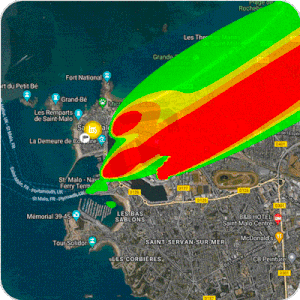How to measure, identify, and precisely locate odors (odours) outdoors?
Odors (odours) are measured, identified, and precisely located by deploying devices either at the source (technical facilities, industrial sites, etc.) or on the periphery of sites to ensure continuous monitoring and a better understanding of odor (odour) dispersion in the environment.
Ellona’s devices, such as the WT1 Pro and WT1 Lite, do more than just measure odor (odour) levels. Thanks to a combination of high-precision MOS sensors and advanced data processing based on multivariate statistical models and artificial intelligence algorithms, our sensors go beyond simple detection: they can analyze odors (odours) in real time, identify their potential sources, and assess their intensity with high reliability.
The WT1 Pro, designed for confined sources, enables precise characterization of olfactory emissions in industrial and urban environments. As a complement, the WT1 Lite, dedicated to monitoring the periphery of sites, ensures continuous tracking of odors (odours) dispersed in the environment, facilitating the assessment of their impact on residents and sensitive areas.
Advanced methods for odor (odour) identification and measurement
Ellona relies on several proven methodologies to refine source identification and odor (odour) fingerprint quantification:
- Source observation and clustering: Remote analysis of odor (odour) intensities, identification of recurring patterns, and mapping of affected areas. This approach considers the temporal recurrence of odors (odours), their intensity, frequency, and duration, enabling a more detailed characterization of nuisances.
- FISOL methodology (Field Input for Source Odor Localization): Combining field data with learning algorithms to pinpoint and qualify odors (odours) based on their duration and recurrence over time.
- Dynamic olfactometry (EN 13725): Available only with the WT1 Pro, this method involves on-site sampling followed by sensory tests in a laboratory. It quantifies odor (odour) levels and establishes correlations between instrumental measurements and human perception, considering the intensity, frequency, and duration of emissions.
Atmospheric modeling and dispersion prediction
In addition to on-site measurements, the integration of atmospheric dispersion models allows for the anticipation and evaluation of the impact of odor (odour) emissions on the environment. These models take into account:
✔ Real-time meteorological conditions (wind direction and speed, temperature, humidity)
✔ Site topography (buildings, terrain, vegetation)
✔ Identified emission characteristics (recurrence, intensity, frequency, duration)
This comprehensive approach not only identifies odor (odour) sources but also predicts their dispersion and optimizes nuisance reduction strategies.
EllonaSoft: A comprehensive analysis platform
All collected data is centralized in EllonaSoft ,an advanced software platform that enables:
✔ Real-time monitoring of olfactory emissions
✔ Correlation of data with weather conditions and dispersion models
✔ Predictive identification of odor (odour) sources
✔ The generation of reports integrating the evolution of nuisances based on their recurrence, intensity, frequency, and duration, to optimize corrective actions
By combining high-tech sensors, atmospheric modeling, and proven methodologies, Ellona offers a complete and effective solution for proactive and optimized management of olfactory nuisances.

Example of Ellona’s calculation models for the precise identification of odor (odour) nature.

Example of a dispersion plume (Plume)